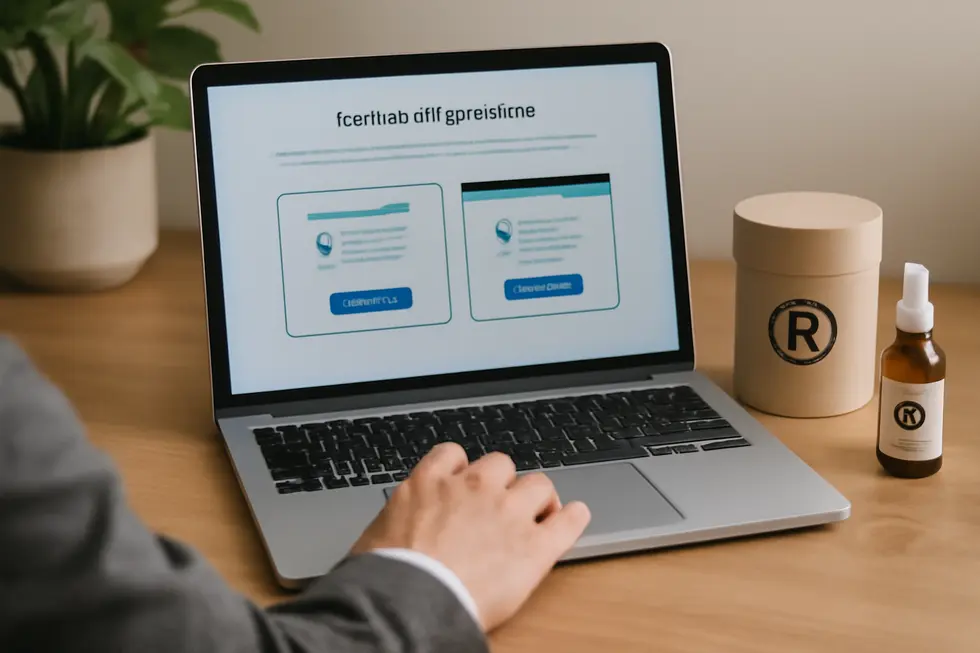Introduction
Securing a trademark is a vital strategy for business owners aiming to protect their brand identity and competitive edge. Trademarks—including names, logos, and slogans—serve as unique identifiers in commerce, safeguarding your intellectual property from infringement and unauthorized use. Navigating the trademark process effectively demands a thorough understanding of each stage, from initial research to long-term maintenance. This guide demystifies the trademark journey: beginning with the crucial step of conducting a comprehensive trademark search; progressing through the careful preparation and filing of your application; following the examination and response procedures managed by the United States Patent and Trademark Office (USPTO); and concluding with insightful practices for maintaining and enforcing your trademark rights. By mastering these essential steps, business owners can confidently secure and sustain their brand’s legal protection nationwide.
Tables of Contents
Chapter 1: How Do You Get Something Trademarked: Conducting a Comprehensive Trademark Search
- Mastering Trademark Uniqueness Verification Through the USPTO’s TESS for a Smooth Application Process
- Mastering Trademark Classification and Application Preparation for a Smooth Registration Process
Chapter 2: How Do You Get Something Trademarked: Preparing and Filing Your Trademark Application
- Mastering the Essentials: Conducting Trademark Search and Proper Classification Before Filing
- Mastering the Trademark Application Process: From Online Filing to Navigating USPTO Examination and Registration
Chapter 3: How Do You Get Something Trademarked: Navigating the USPTO Examination and Office Action Process
- Mastering Application Filing and Initial USPTO Review to Secure Your Trademark
- Mastering Office Action Responses and Trademark Maintenance to Secure Your Brand
Chapter 4: How Do You Get Something Trademarked: Maintaining and Enforcing Your Registered Trademark
- Navigating Trademark Registration and the Crucial First Steps of Maintenance and Enforcement
- Sustaining and Protecting Your Trademark: Essential Practices for Long-Term Legal Strength and Brand Integrity
Chapter 1: How Do You Get Something Trademarked: Conducting a Comprehensive Trademark Search

1. Mastering Trademark Uniqueness Verification Through the USPTO’s TESS for a Smooth Application Process
Before applying to trademark your brand’s name, logo, or slogan, determining its uniqueness is essential to avoid conflicts and rejection. The United States Patent and Trademark Office’s (USPTO) Trademark Electronic Search System (TESS) serves as the authoritative, publicly accessible database for this critical step. TESS provides an extensive archive of millions of existing registered trademarks and pending applications, allowing you to identify potential overlaps or confusingly similar marks.
Using TESS requires no special software or registration—simply accessing the online platform lets you begin. Starting with a basic word mark search, you enter the exact trademark you wish to protect. This search will reveal identical or closely similar trademarks. However, trademarks are registered within specific product or service classes. Therefore, it’s not enough to find duplicates; you must also consider whether any similar marks are registered in the same or related classes as your intended use because the USPTO scrutinizes potential likelihood of confusion within these fields.
If the initial search indicates no direct conflicts, further refinement through TESS’s advanced search capabilities is advisable. Advanced queries enable filtering results by parameters such as owner names, registration status, registration dates, or specific descriptions of goods and services. This is especially necessary when working with common words, phrases, or slogans that might appear in numerous registrations across multiple industries.
Analyzing search results demands careful attention to detail. Identical trademarks in unrelated classes might not prevent registration, but marks that are confusingly similar in the same class or closely related sectors pose significant obstacles. If your preliminary search reveals such conflicts, your trademark application could face office actions or outright refusal later in the USPTO examination process.
Given the complexity and nuanced nature of trademark similarity assessments, engaging a qualified trademark attorney or professional search firm can greatly improve the accuracy of your search and interpretation. These experts bring legal insight that goes beyond what raw search results show, helping you navigate borderline situations and advising on the best path forward.
Successfully confirming your mark’s distinctiveness using TESS lays the foundation for an effective application. Once your search shows a clear path, you can confidently proceed to submitting your trademark application, reducing the likelihood of delays or legal challenges. Beyond just searching, understanding the context in which trademarks coexist helps protect your brand’s identity and commercial value.
To deepen your understanding of trademark protections related to business identifiers, consider exploring trademark protection for business names and logos.
For direct access and practical use, the USPTO TESS database is available at: https://www.uspto.gov/trademarks-application-process/search-trademark-database.
2. Mastering Trademark Classification and Application Preparation for a Smooth Registration Process
After conducting a thorough trademark search to ensure your mark’s uniqueness, the next critical phase is carefully preparing your application with precise classification and documentation. This preparation sets the foundation for a smooth registration journey and helps avoid delays or refusals.
Trademarks are registered within specific classes that categorize goods or services. Each class defines the scope of protection your trademark will receive. Selecting the correct class is essential because your exclusive rights will apply only within those categories. For instance, a mark registered in a class for clothing will not automatically cover software products. The United States and many other jurisdictions follow the Nice Classification system, which organizes goods and services into 45 distinct classes. Identifying the most appropriate class or classes requires a clear understanding of your business offerings and potential future expansions. Erroneous or incomplete classification can limit your trademark’s protection or result in higher future costs for additional registrations.
Once classification is decided, you must prepare a comprehensive trademark application. This involves providing the exact mark—whether it is a word, logo, or slogan—in the required format. You will also need to submit a specimen demonstrating actual use of the mark in commerce, such as a product label, packaging, website screenshot, or marketing material. This specimen provides tangible proof of your trademark’s use, a prerequisite for many trademark offices including the USPTO.
Applicants must also choose the type of application suited to their situation. For example, in the U.S., the Trademark Electronic Application System (TEAS) offers two main forms: TEAS Plus and TEAS Standard. TEAS Plus requires more detailed information upfront and carries a lower filing fee; TEAS Standard is more flexible but costlier. Fees paid during filing are generally non-refundable, emphasizing the importance of diligent preparation.
After submission, the trademark office assigns an examining attorney to carefully review the application. If the examiner finds conflicts with existing trademarks or procedural issues—such as incorrect classification or specimen problems—an official “office action” will be issued. You must respond to this within a limited timeframe, typically three months, to address concerns or provide clarifications. Failure to respond timely or adequately can lead to application abandonment.
Successfully navigating this phase results in registration, conferring nationwide exclusive rights within the specified classes. These rights empower you to prevent others from using confusingly similar marks in the same categories, securing your brand’s commercial identity.
Being meticulous with classification and application preparation dramatically increases your chances of a successful trademark registration. This process ensures your mark is protected legally and commercially, guarding your business’s unique identity.
For an expanded overview of the US trademark registration process, visit this detailed guide: https://www.indiafilings.com/learn/us-trademark-registration/.
For additional insights on maintaining and protecting your brand identity after registration, explore our resource on trademark protection of business names and logos.
Chapter 2: How Do You Get Something Trademarked: Preparing and Filing Your Trademark Application

1. Mastering the Essentials: Conducting Trademark Search and Proper Classification Before Filing
Before filing a trademark application, the most crucial step is preparing it meticulously to avoid delays or rejection. The foundation for this preparation lies in conducting a thorough trademark search and accurately classifying your goods or services. These actions ensure your mark’s uniqueness and align your application with legal requirements established by the United States Patent and Trademark Office (USPTO).
The trademark search is a deep-dive investigation to confirm that your desired mark is not already in use or registered, avoiding conflicts that can derail your application. This search primarily involves using the USPTO’s Trademark Electronic Search System (TESS), which allows you to scan federally registered and pending trademarks. However, an effective search goes beyond exact matches. It examines similar-sounding or visually alike marks within the relevant trademark classes, as these could still pose an obstacle. To widen the scope, checking other sources like domain registrations, social media, and international trademark databases may be necessary, especially if your business has cross-border aspirations. While you can perform preliminary searches independently, the expertise of trademark attorneys or professional search firms often proves invaluable — they apply a broader understanding of trademark law nuances and uncover hidden conflicts.
After establishing that your trademark is distinct enough, the next important step is the precise classification of the goods or services your mark will cover. The USPTO follows the internationally recognized Nice Classification, which divides goods and services into 45 categories or classes. Identifying the correct class(es) is essential because trademark applications are evaluated within those classes, and fees apply per class selected. For instance, a trademark for a clothing line would fall under one class, while a trademark for software or consulting services would fall under different ones. Selecting the right classes ensures your mark is protected where it matters most for your commercial activities. Misclassification or under-reporting can leave vital aspects of your brand unprotected or cause refusals and delays.
Once you have completed a comprehensive search and clarified your trademark’s classification, you gather the detailed information necessary for the application itself. This includes the exact trademark type—whether a word mark, logo, or slogan—and the basis for filing, such as actual use in commerce or intent to use. Accuracy here is paramount since all details must withstand a rigorous review process.
Finally, you submit your application through the USPTO’s Trademark Electronic Application System (TEAS), choosing the filing option that best fits your needs between TEAS Plus and TEAS Standard. Fees are due at this stage and are nonrefundable, reinforcing the importance of thorough preparation before filing. The correct classification combined with a diligent trademark search dramatically improves the chances of a smooth application journey.
For more insight into trademark preparation and how classification impacts protection, consulting a trusted trademark service can provide tailored support and ensure your brand’s strongest safeguards.
Detailed official guidance on the USPTO submission process can be found here: USPTO Trademark Application Process.
2. Mastering the Trademark Application Process: From Online Filing to Navigating USPTO Examination and Registration
Filing a trademark application marks a pivotal stage in securing legal protection for your brand’s unique identifiers. After confirming your mark’s uniqueness through a thorough search, the next crucial step is preparing and submitting your application to the United States Patent and Trademark Office (USPTO) using their Trademark Electronic Application System (TEAS). This online filing portal enables you to formally apply for federal trademark registration by providing detailed information about your mark and its commercial use.
Your application must include a precise representation of the mark—whether a word, logo, or slogan—along with an accurate description of the goods or services it will identify. Additionally, you’ll need to specify the applicant’s legal name, address, and entity type (like individual, corporation, or LLC). A key element in the application is the filing basis, indicating whether you are already using the mark in commerce or intend to use it in the future. Alongside this, submitting a specimen illustrating the mark’s actual use or planned use underpins your claim to trademark rights.
Within the TEAS system, you have two filing options: TEAS Plus and TEAS Standard. TEAS Plus offers a lower filing fee but requires more upfront information and adherence to specific application criteria. TEAS Standard allows greater flexibility but at a higher cost. Choosing between these depends on how well-prepared your documentation is and how narrowly your goods or services align with the USPTO’s accepted classifications.
Once submitted, your application enters an examination phase where a USPTO examining attorney scrutinizes it for compliance with all formal requirements and checks for conflicts with existing trademarks. This review process, which typically lasts several months, may identify issues such as similarity to pre-existing marks or incomplete application details.
If any problems arise, the USPTO issues an office action outlining the concerns and requiring a response, usually within three months. Responding promptly and adequately to office actions is essential to avoid abandonment of the application. This dialogue with the examining attorney may involve clarifying descriptions, amending specimens, or contesting refusals.
After overcoming all hurdles and successfully resolving any objections, your mark will be published in the Official Gazette, granting others an opportunity to oppose registration if they believe it would harm their rights. If unopposed or opposition fails, the USPTO issues a registration certificate formally granting you exclusive trademark rights nationwide for the specified goods or services.
Following registration, you must maintain your trademark by filing periodic maintenance documents and demonstrating continuous commercial use. Failure to do so risks registration cancellation.
By understanding and navigating this application, examination, and registration process, you can secure strong legal protection that preserves your brand’s identity and market presence. For more detailed guidance on trademark registration timelines and procedural nuances, consult the comprehensive US Trademark Registration Guide.
For practical insights into protecting your brand name and logo, the resource on trademark protection for business name and logo offers valuable information relevant to this stage of securing your brand.
Chapter 3: How Do You Get Something Trademarked: Navigating the USPTO Examination and Office Action Process

1. Mastering Application Filing and Initial USPTO Review to Secure Your Trademark
Securing a trademark begins with meticulous preparation and a strategic approach to filing your application with the United States Patent and Trademark Office (USPTO). The first essential step involves conducting a thorough search through the Trademark Electronic Search System (TESS) or the new USPTO Trademark Search system to confirm that your proposed mark is not already in use or registered by another party. This step is critical in avoiding conflicts and potential refusals based on similarity or existing rights.
Once confident your mark is unique, you proceed to file your application online using the Trademark Electronic Application System (TEAS). Among the filing options, the TEAS Plus form is generally preferred for its streamlined process and lower fees, although it requires stricter initial compliance. The application must include precise details about the mark itself—whether a word, logo, or slogan—alongside a clear description of the goods or services with which the mark will be associated. Additionally, submitting a specimen is mandatory; this specimen serves as tangible evidence of the mark’s use in commerce or shows bona fide intent to use the mark, depending on your filing basis.
After submission, the USPTO assigns an examining attorney to review your application rigorously. This attorney examines whether your mark complies with all statutory requirements and evaluates potential refusals. Factors such as descriptiveness, possibility of confusion with prior marks, or any other legal grounds for refusal are carefully assessed. If the examining attorney identifies issues, they issue an Office Action detailing the reasons your application cannot proceed as is. You must respond thoroughly and within six months to overcome these objections. Addressing every concern diligently is key to advancing your application.
Should the examining attorney find no issues or once you have successfully resolved any Office Actions, your trademark will be published in the Trademark Official Gazette. This publication phase opens a window for third parties to oppose your registration. If no opposition is filed, or if oppositions are resolved favorably, registration will follow promptly if your application is based on actual use. For intent-to-use applications, a Notice of Allowance is issued instead, requiring you to submit a Statement of Use to finalize registration.
Throughout this intricate process, attention to detail and adherence to deadlines are paramount. A well-executed search, a complete and accurate application, and a prompt, well-crafted response to the USPTO’s office actions form the backbone of successfully navigating the trademark examination stage. To ensure you have the right tools and official guidance, the USPTO’s own Trademark Search resources are invaluable.
For business owners aiming to protect their brand identity comprehensively, understanding and mastering these procedural steps is foundational. This knowledge not only prevents delays and refusals but solidifies the path toward obtaining exclusive trademark rights that safeguard your brand nationally.
2. Mastering Office Action Responses and Trademark Maintenance to Secure Your Brand
When you submit your trademark application to the USPTO, it undergoes scrutiny by an examining attorney who assesses its compliance with trademark laws. Often, the examiner may raise concerns resulting in an Office Action—a formal letter outlining objections or required modifications. Properly responding to these Office Actions is a pivotal stage in securing your trademark registration. The examiner’s reasons can vary; common issues include the mark being too descriptive, a likelihood of confusion with a previously registered mark, or procedural inconsistencies in your application.
The first step in addressing an Office Action is to carefully analyze its content. Understanding the precise arguments against your mark allows you to craft a targeted response. Your reply must fully resolve all points raised, which often involves presenting legal arguments demonstrating why the examiner’s refusals should be reconsidered. This could include clarifying the distinctiveness of your trademark, submitting evidence of actual use in commerce, or amending the goods and services descriptions to alleviate conflicts. When necessary, adjusting or refining your mark in the application can facilitate approval without compromising your brand identity.
Timing is critical. You generally have three months from the issuance date of the Office Action to respond. This window can be extended once by up to three additional months, provided a fee is paid. Missing this deadline means your application will be considered abandoned, forfeiting your registration opportunity. Given the legal complexity involved in crafting persuasive arguments or amendments, many applicants find it beneficial to seek guidance from a trademark professional familiar with USPTO practices and the Trademark Manual of Examining Procedure (TMEP).
If your reply satisfactorily addresses the examiner’s concerns, the application moves forward to publication for opposition, and if unopposed, registration follows. However, navigating this phase can often entail multiple rounds of correspondence, underscoring the importance of a comprehensive and timely response.
Once your trademark is registered, maintaining your rights is equally important. The USPTO requires that owners file specific maintenance documents to demonstrate continuous use and renew the registration. Between the 5th and 6th year after registration, a Section 8 Declaration must be filed to verify active commercial use of the mark. Later, every ten years, the trademark must be renewed by filing a combined Section 8 and Section 9 application to preserve protection. Neglecting these filings results in cancellation or expiration, leaving your brand vulnerable.
Effective management of Office Actions and conscientious adherence to maintenance filings ultimately secure your exclusive legal rights nationwide. This commitment solidifies your trademark’s role as a valuable business asset, protecting it from infringement and unauthorized use throughout its lifecycle. For further insight into trademark protection essentials, exploring resources on trademark protection for business names and logos can offer practical guidance.
More information on the examination and office action process is available through the USPTO’s official explanations on Office Actions and deadlines.
Chapter 4: How Do You Get Something Trademarked: Maintaining and Enforcing Your Registered Trademark

1. Navigating Trademark Registration and the Crucial First Steps of Maintenance and Enforcement
Securing a trademark involves more than simply applying for registration; it requires a methodical approach to registration itself and the early actions that ensure your trademark remains protected and enforceable. The process begins by conducting a comprehensive trademark search to confirm that your proposed mark is truly unique and does not conflict with existing marks. This step is essential to mitigate the risk of application rejection or costly legal disputes down the line.
Once you confirm the availability of your trademark, you proceed with filing your application through the United States Patent and Trademark Office’s online Trademark Electronic Application System (TEAS). Applicants can select either the TEAS Plus option, which is more cost-effective but demands stricter initial compliance, or the TEAS Standard, which allows more flexibility at a higher filing fee. Your application must include precise details about the trademark itself—whether a word, logo, or slogan—and the goods or services it identifies, along with a specimen showing its use in commerce.
After submission, an examining attorney at the USPTO reviews your application for compliance with legal standards and prior registrations. If issues arise, such as potential infringement or technical deficiencies, you will receive an office action outlining required corrections or clarifications. Responding promptly and thoroughly to office actions is vital to avoid abandonment and advance towards registration. Approved applications proceed to publication in the Official Gazette, giving third parties a chance to oppose if they believe your trademark infringes on their rights. If no opposition is sustained, the trademark is registered, granting you exclusive nationwide legal rights.
The entire registration process typically spans 8 to 18 months, depending on complexity and response times. However, registration is only the starting point for maintaining your rights. You must continuously use your trademark in commerce as a condition for retaining your registration and to avoid abandonment. Additionally, strict federal maintenance filings are required, including a Declaration of Use filed between the fifth and sixth year after registration, and renewal applications every ten years. Failure to meet these deadlines can jeopardize your trademark’s protection.
Active enforcement is equally critical. Trademark owners should monitor the market vigilantly for unauthorized uses or confusingly similar marks that may dilute or infringe their rights. Prompt legal action to enforce your trademark deters infringement and preserves its strength. Moreover, if you decide to assign or license your trademark, it is crucial to properly document such arrangements to prevent loss of control or challenges to your rights.
Due to the complexity and nuance involved, consulting a trademark attorney can provide invaluable guidance in navigating registration and sustaining your trademark rights effectively. For a detailed guide on protecting your brand through trademark registration, see Trademark Protection for Your Business Name and Logo.
Following these registration and initial maintenance steps ensures that your trademark not only gains official recognition but remains a powerful asset to safeguard your brand identity and commercial value.
More information on the USPTO trademark application and maintenance process can be found at the USPTO Trademark process and requirements.
2. Sustaining and Protecting Your Trademark: Essential Practices for Long-Term Legal Strength and Brand Integrity
Securing your trademark registration marks only the beginning of a vital journey to preserve your brand’s exclusive legal rights. Long-term maintenance of a registered trademark demands consistent, proactive efforts to sustain its protection and value in the marketplace.
First and foremost, continuous use of the trademark in commerce is crucial. Trademark law generally considers a mark abandoned if it is unused for three consecutive years, potentially causing the loss of registration rights. Therefore, carefully integrating your mark into actual sales, marketing, or services keeps it active and firmly associated with your brand identity.
In addition to use, federal maintenance filings must be submitted periodically to keep the registration in good standing. The USPTO requires owners to file between the fifth and sixth year after registration a Section 8 Declaration, affirming continued use of the trademark. Failure to file this can lead to cancellation. Subsequently, every ten years, a combined Section 8 and Section 9 Renewal Application must be submitted. These renewals demonstrate ongoing commerce use and ensure your trademark remains federally enforceable. Missing these deadlines automatically removes your trademark’s protections, so conscientious tracking is essential.
Beyond formal filings, vigilant monitoring of the marketplace is fundamental. Unauthorized or infringing use of your trademark dilutes its distinctiveness. By regularly reviewing competitors’ offerings and trademark databases, you can spot potential conflicts early. Enforcing your rights often begins with sending cease-and-desist letters to halt infringement, which can preempt costly litigation. When necessary, pursuing legal action protects your brand from unauthorized exploitation that could confuse consumers or damage your reputation.
Maintaining proper trademark usage also avoids the mark’s genericization—the process by which the public starts using a trademarked term as a generic name for similar products or services. This common pitfall has stripped many famous marks of their protection. Using the ® symbol prominently once registered reinforces your legal claim and educates the public on your exclusive rights.
For businesses operating beyond federal boundaries, state-level registrations and international trademark protections may also be advisable. These layers provide additional safeguards for your mark in different jurisdictions and can be crucial for growth or expansion plans.
Legal experts specializing in trademark law can offer valuable guidance during maintenance, enforcement, and dispute resolution phases. Their expertise ensures that you navigate office actions, oppositions, or infringement claims efficiently, preserving your trademark’s strength for years to come.
Ultimately, sustained legal protection of your trademark requires a carefully managed blend of continuous use, timely compliance with USPTO requirements, diligent market oversight, and assertive enforcement actions. Such a comprehensive approach not only maintains your federal trademark registration but also solidifies your brand’s integrity and commercial value.
For more insights on protecting your trademark as a crucial business asset, consider exploring comprehensive trademark protection strategies.
For official procedural details concerning trademark maintenance filings, visit the USPTO’s Trademark Electronic Application System (TEAS) resources at https://www.indiafilings.com/learn/us-trademark-registration/.
Final thoughts
Successfully trademarking your brand involves a multi-step process that requires diligence, precision, and ongoing commitment. From performing a thorough trademark search to prepare a strong application, filing correctly using USPTO systems, responding promptly to any office actions, and maintaining your registration, each phase plays a crucial role in securing your exclusive rights. For business owners, this legal protection not only fosters brand integrity but also provides powerful recourse against infringement, boosting your market position and customer trust. Embracing this comprehensive approach ensures your business’s unique identifiers remain yours, legally safeguarded for years to come.
Your IP is the foundation of your success – let’s protect it together before it’s too late. We can’t wait to help you turn your ideas into legally secured assets.
About us
undefined



Can you be more specific about the content of your article? After reading it, I still have some doubts. Hope you can help me. https://accounts.binance.com/hu/register-person?ref=IQY5TET4